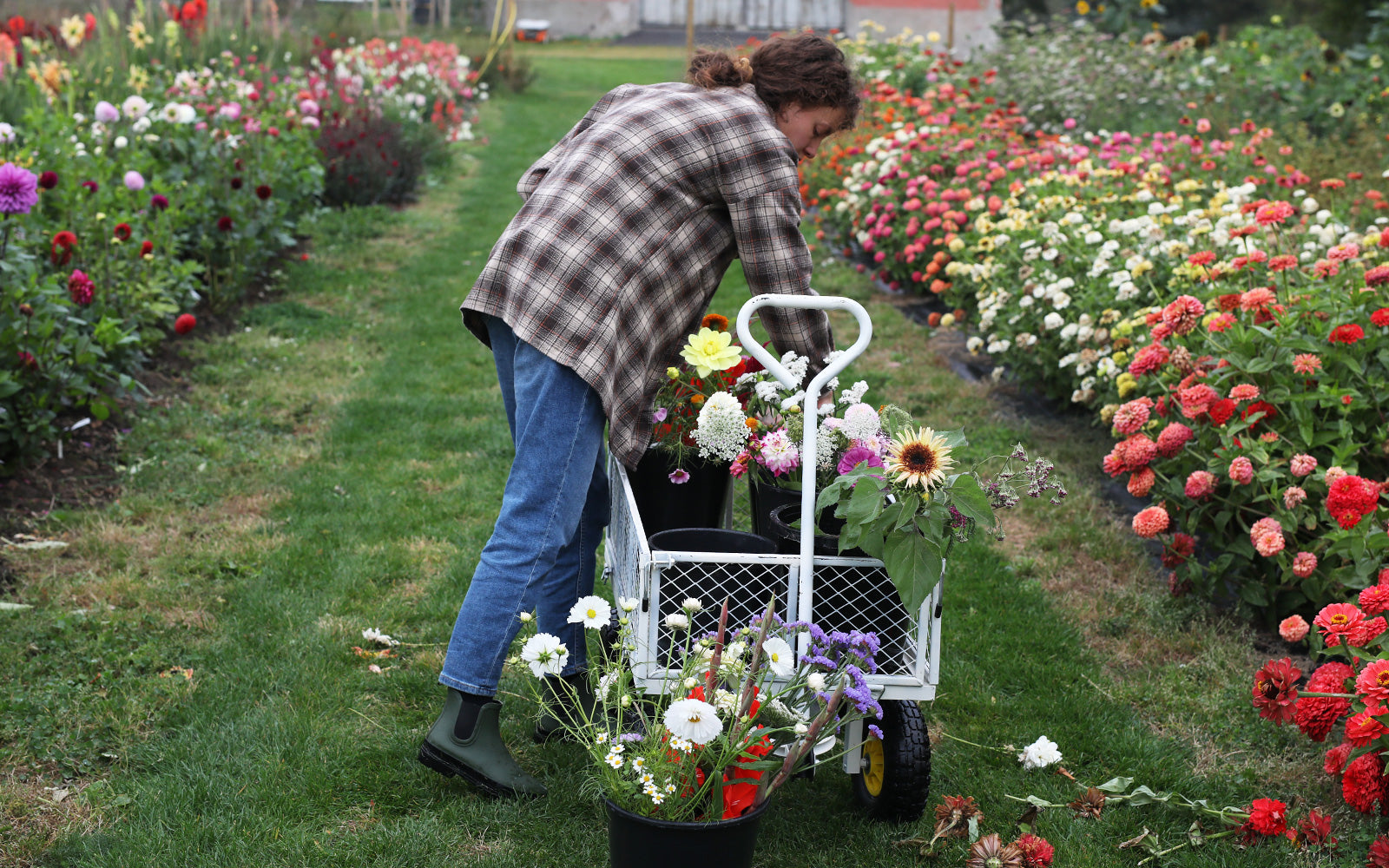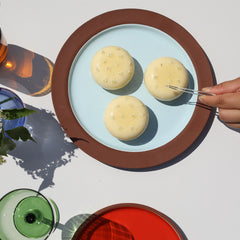
When we buy flowers for bouquets and vases, we often buy flowers that are sprayed and imported from abroad without thinking about the CO2 emissions and the burden on our climate and environment. In Denmark, we are incredibly enriched with many beautiful flower varieties that can be bought locally from the Danish flower farmer or can easily be grown in your own garden. We have therefore visited the flower farmer Louise and her flower farm Blomstergården Øster Bisholt to focus on Danish flower farmers and all the beautiful flowers that can be grown in Danish gardens.
This article is the 2nd part about Louise, and deals with daily life at Blomstergården, the flower growing process and tips and tricks for your own flowers.
You can read the first part of the article here , which focuses on Blomstergården's beginnings and vision to grow beautiful and rewarding flowers in local and more sustainable surroundings.

FLOWER FARM EAST BISHOLT
Blomstergården Øster Bisholt is the pure farm idyll with beautiful seasonal flowers. Louise started the flower garden in 2020 with the aim of growing Danish, local and natural flowers, thereby creating a greater focus on Danish flowers, flower farmers and their growing potential.
Blomstergården has great concern for nature, nature's cycle and the environment. Therefore, the selection is seasonal, where summer flowers and perennials are grown in summer, and dried flowers and evergreens are used for decorations in autumn and winter. The plants are grown naturally without the use of pesticides and artificial fertilizers and with a view to local sales. Louise's philosophy is that flowers should not overperform, last unnaturally long or be forced to be perfect. There is a greater quality and soul in natural and real flowers, which many often forget, and Louise hopes to be able to pass this on with her flowers.

A TEACHING WORKING PROCESS
Growing flowers is a careful and somewhat time-consuming process - but it's all worth it when you stand with an exuberant, home-grown flower bouquet in your hand. For Louise, it takes about a year from planning which flowers to grow to the flowers blooming in the garden.
Louise is a descendant of agricultural farmers, but does not have an agricultural or flower education herself. She has instead acquired her knowledge through books, social media and gardening programs such as Gardeners' World.
Most importantly, she has learned and gained experience through mistakes. Growing flowers is a learning process and therefore you should not be afraid of making mistakes or be sad that you will kill some flowers, because it will happen to everyone!

FLOWERS ALL YEAR ROUND
If you would like to have cut flowers all year round or for a longer period of time, it is good advice to grow a mix of different flower species that bloom at different times of the year.
"In the spring, you can use flower bulbs such as daffodils and tulips, possibly combined with branches from bushes that hold up well in the vase. In late spring, you can use biennial flowers and perennials - perennials are those that grow up and wither year after year. In summer, you can harvest from the annual plants. In late summer, the dahlias take all the spotlight, accompanied by the 1-year-olds. And when the frost hits and most flowers die back, you can use all the evergreens such as pine cones and spruce, and of course all the dried flowers that you harvested for drying over the summer." - Louise
When Louise makes a living from selling her flowers, it requires a slightly more extensive system, where she sows over several rounds to spread the flowering out:
Fall
In autumn, she sows hardy annual flowers that can withstand mild frost. They stand throughout the winter and form a strong root network, which gives a slightly earlier flowering and more flowers in the spring. In addition, she takes dahlia tubers out of the ground and stores them in a frost-free place, and places flower bulbs such as tulips and daffodils in the beds instead.
Spring
In early spring, Louise sows a new round of hardy annual flowers, which can be planted out before the last frost. When the last frost is over, she sows the non-hardy annual flowers over several rounds to spread out the flowering.
In the spring, she also sprouts dahlia tubers and puts them in the ground after the last frost.
Summer
In the summer, she sows the plants that can grow to bloom before the frost. In addition, she sows the biennial flowers and plants, which will only bloom the following season.
In this way, you can always have a varied selection for your flower bouquets and decorations. If, of course, you just want to enjoy the flowers in your garden on a more relaxed hobby level, such extensive planning and structuring of the flowers is not necessary.
CHOICE OF VARIETIES AND FLOWER STYLES
Louise's style is constantly evolving, and she loves to play and be creative. Therefore, she simply chooses what she is attracted to, which is often bright, strong colors, such as blue and orange.When Louise creates flower bouquets, she tries to make them dynamic. If it is a compact and dense bouquet, she adds spiky flowers or plants, which break the shape and make it a little airier. At the same time, she also creates focal points for the eye in an airy bouquet by placing large flower heads at the same height, so that the bouquet still has some structure in its shape.

LOUISE'S GREEN TIPS AND TRICKS
Bouquets with a sustainable conscience
Find out how you can support your local flower farmer, avoid buying imported flowers from grocery stores, seek out pick-your-own fields, harvest from the wild and ditch edges, or grow them yourself. Use what is in season and see it as a creative challenge to make use of a limited selection.
Get fresher flowers and long-lasting bouquets
Research which stage the individual flower is best harvested in. This varies from flower to flower, but in general most flowers are best harvested just before they fully bloom.
Harvest in the early morning hours or late evening hours, as the flowers are filled with the most water at these times. Let the flowers rest in a bucket filled with clean water for a few hours, preferably overnight. This way they should be saturated enough for a fresh bouquet.
Do not place the flowers in direct sunlight, as they will debloom faster due to the light and heat.
Change the water in the vase often so that the flowers get fresh nourishment. You can see more tips on how to extend the life of your bouquet on Blomstergården's website.

General tips for a beginner in the green world
- Go ahead and get down to business with a flower project that you are passionate about. "I myself have been (and sometimes still am) the wildest control freak, but nature has really taught me to let go, because it has to manage and choose the best possible conditions to thrive." - Louise
- Don't overdo it in the beginning, because it's not very motivating to finish something that you think is a burden or you're not invested in. For example, choose 5 types of flowers that you think are beautiful to begin with.
- Supplement your bouquets with ditch edge flowers, plants or branches from nature.
- Get inspired in books, garden programs and social media such as Instagram, Facebook or Pinterest.
- Search communities where you can share ideas, advice, thoughts and frustrations. The flower world offers a lot of rewarding and pleasant communities with other garden enthusiasts and flower farmers within specific interests, for example cutting gardens, flower arranging, dried flowers etc. These flower farmer communities are only something Louise dreams of getting bigger.
You can find Louise on her instagram @blomstergaarden-oesterbisholt and website https://www.blomstergaarden-oesterbisholt.dk/ , where she also has a map of all Denmark's flower farmers.



